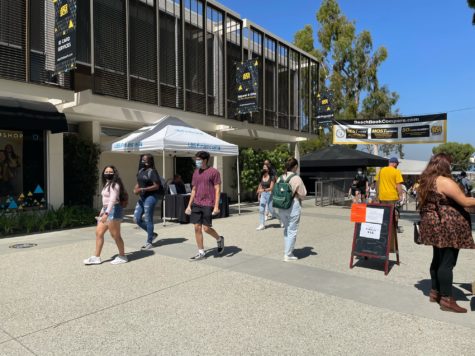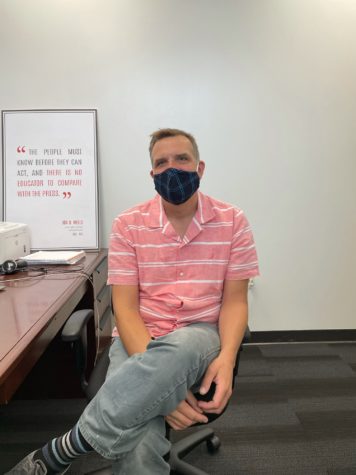By: Aric Pun & Kayla Ronquillo
After attending three classes the day before, Natalie Alvarez, a graduate student at the School of Social Work at Long Beach State, woke up on the morning of Aug. 31 realizing that she had lost her sense of taste and smell.
Alvarez is vaccinated, having gotten her second dose in April of this year. Still, she went to get tested.
It came out positive.
Gregory Woods, CSULB manager of media relations and visual journalism, said so far 97% of students coming to campus have indicated that they are fully vaccinated.
While the vaccination rate is high, there have still been 19 confirmed on-campus cases as of Monday, Sept. 20. Speaking to a few students and a professor at the university who have dealt with COVID-related issues, there has been confusion about how to deal with cases that do come up and what the protocol is.
So what happens when an individual on campus tests positive?
CSULB’s COVID-19 webpage states that students who believe they have contracted COVID, or believe they know a student that may have contracted COVID, should fill out a case report form that is sent to Student Health Services (SHS) for verification.
Contact tracing is done through “both voluntary reports of symptoms and illness from Beach community members as well as pre-arrival daily health screening information,” according to step 10 on the university’s COVID-19 webpage.
“We speak with the individual and identify days and times that they were on campus during the window of exposure,” Allison Borwell, a health educator at SHS, said. “We then notify those who were at risk that an exposure has occurred and give them instructions based on their vaccination status.”
The total number of students at CSULB for the fall 2021 semester could not be verified due to the official campus census not being ready until October.
But with 42% of classes taught in-person, it is estimated that there are an average of 13,000 to 15,000 students on campus Mondays through Thursdays, with a drop on Fridays, Woods said.

Before coming on campus, every student needs to complete a pre-screen survey that determines whether students are eligible to attend classes that day based on their answers.
“Students who are symptomatic with suspected COVID will not be cleared to come to campus,” Borwell said.
With Alvarez not knowing what to do after she tested positive, she decided to notify a professor about the situation.
The professor told her to “contact SHS right away,” Alvarez said.
“We had a full-on conversation,” she said. “If I was vaccinated, any symptoms I’ve had, how many days I had symptoms.”
The faculty member Alvarez spoke to on the phone informed her that she would have to quarantine for 10 days before being allowed back on campus.
In the event of a classroom exposure, Student Health Services works with Enrollment Services to send notices out to the faculty and all students. While Academic Affairs and other individual departments coordinate any subsequent plans, Borwell said.
Alvarez and the other students in her program were emailed by SHS the following day, stating that classes would be switched to online for a week.
Classes were to resume in-person on Thursday, Sept. 9, but were then extended to Wednesday, Sept. 15, for unknown reasons.
Alvarez speculates more positive cases were confirmed within the program, but the email never specified why.
“It just doesn’t make any sense to bring back so many kids to school, knowing that COVID is still a thing,” Alvarez said. “Even though you know that you are keeping safe and doing procedures to keep everyone safe, you don’t know what other people are doing in their own lives.”
Todd Henneman, a journalism professor at CSULB, said that he wasn’t given clear directions on what would happen if a student in his class were to test positive for COVID, and it turns out there’s a reason.

“We modify plans as needed based on the guidance from our local public health departments, which has changed throughout the course of the pandemic,” Borwell said.
Another issue Henneman had was with the case report form.
A student in Henneman’s online class informed him that she had tested positive for COVID.
“My thought was, well, I don’t have to worry about the other students in the class because it’s an online class,” Henneman said. “But I have no idea what other classes she’s taking. And it seemed to me that there should be some sort of process. My first thought was, ‘why am I not being contacted by health services?'”
Despite looking for answers on the COVID guideline website, it didn’t have what he was looking for, so he reached out to SHS.
“And the response I got was, a lot of faculty members just fill out the form themselves, rather than have the students fill it out,” Henneman said.
According to the COVID-19 webpage, if a student, faculty or staff member believes they have contracted COVID, they should immediately report the illness to their supervisor.
Sean Terry, a senior majoring in criminal justice, had a class canceled for a week after his professor’s four-year-old child tested positive for COVID-19.
The professor, who Terry asked to keep anonymous, did not test positive for the virus.
While the assignments for the class are posted online through BeachBoard, there have been no online lectures to substitute Terry’s canceled class sessions.
“My teacher didn’t really tell us anything besides he was going to be out due to his kid having COVID,” Terry said. “I was confused at first because it all seemed so casual.”
Taylor Aldape, a fourth-year public relations major, had a close run-in with COVID after visiting her brother who unknowingly contracted the virus at the time.
She missed some class time to quarantine, but nevertheless tested negative.
Aldape said that with so many people on campus, she wishes more classes were hybrid or offered both on-campus and online components.
“There are still people who are unvaccinated and anti-maskers,” Aldape said. “We still have a lot of work to do in classes with other people so you’re always introduced to someone else.”
In regards to student safety, Aldape said, the university is doing a little more than the bare minimum.
“They could be doing so much,” Aldape said. “They could’ve had more hand sanitizer stations. I haven’t seen one worker cleaning or anything.”




